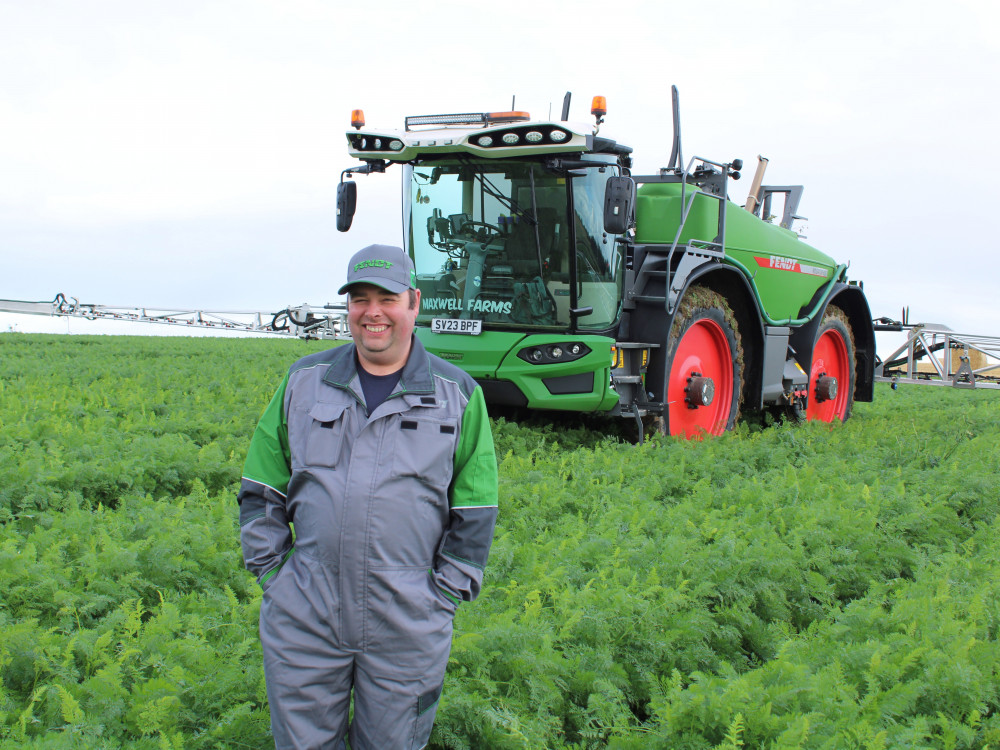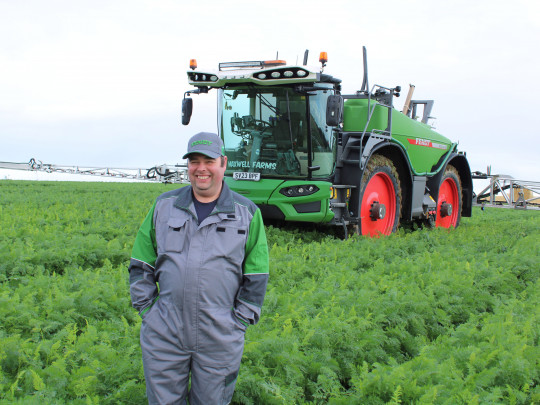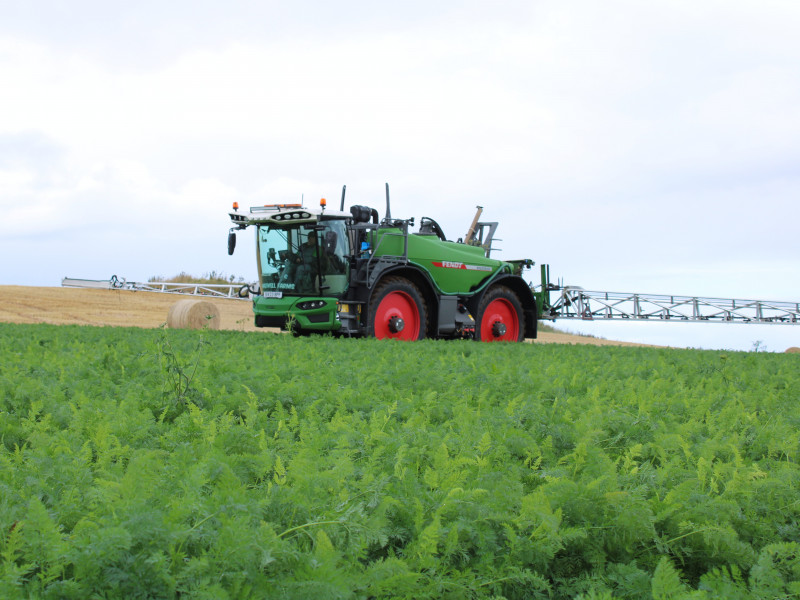

Why a self-propelled sprayer is a must
8th Nov 2024
Weather windows are the biggest challenge for arable and vegetable grower Maxwell Farms, which is why a self-propelled sprayer is a must. Operator Steven Paterson told us about how his Fendt Rogator 655 is helping to capitalise on the narrow opportunities he has to protect the farm’s crops.
The Rogator is part of a Fendt fleet that has been sourced from and maintained by us. Maxwell Farms employs 15 fulltime staff and additional seasonal workers to manage 2,000 acres near Turiff in Aberdeenshire.
The business was started in 1956 and is managed by brothers Peter and Graham Maxwell. Built on supermarket contracts for swedes initially, it now grows late season carrots, cereals and distributes seed potatoes worldwide.
“There is relatively little downtime for the sprayer. We bought the Fendt in 2023 so it’s almost completed its second season and it has been operated for 1635 hours and sprayed 12,761 hectares travelling 22,000 kms,” says operator Mr Paterson.
Such heavy use has come with no maintenance or technical issues and the big Fendt has got on with all the tasks thrown at it with consummate ease. Crops are spread over a 35-mile radius from the main farm, which sees the sprayer cover long distances on the road.
“It is so easy to operate and to live with. I have to do a lot of road hours - of the 1,635, almost a third have been on the road. The Fendt cab is a dream. It’s quiet, everything is at your fingertips and, whilst the joystick is different to the tractors, it gives me everything in one place, including the hydraulics and wheel motors,” he says.
The Rogator’s FendtONE interface is shared across many tractors in the fleet making the exchange of data and information easy for both operator and farm manager. Data collected by Mr Paterson can be shared to monitor efficiency and improve crop monitoring throughout the year.
“The screens are intuitive and easy to use. The data that is collected is also really useful to me and others on the farm,” he adds.
On the road, the Fendt’s 272 horsepower engine sees it to a top speed of 50km/h. However, at 40km/h the engine is only running at 1750rpm, making it an economical machine to run, even at higher speeds.
This, combined with Fendt’s HydroStar CVT drivetrain which drives each wheel individually, offers permanent four-wheel drive that also saves fuel.
“Since it was delivered, I have used 22,778 litres of fuel to travel 22,000 kilometres. It is the most fuel-efficient sprayer I have come across and it doesn’t skimp on performance to provide this level of fuel efficiency,” he says.
The spraying season starts in February and runs through until early November some years. Crops like the carrots, that are covered with straw and plastic, receive a careful balance of fungicides and herbicides to protect the crop from disease.
“We are always looking to minimise damage and, because we have no access to the carrot crop when it is covered from October to April, it is vital that a comprehensive spraying routine is carried out,” he says.
Carrots will be treated pre-emergence, receive a weed spray, three further weed treatments and a fungicide treatment every two weeks until the crop is covered. Potatoes receive up to 11 blight sprays per crop and swedes, like the carrots, are on a fortnightly fungicide program until harvested in October.
“It works out to about 1,000 hours per season and the weather windows are making it longer and harder to get around the crops. The boom control on the Fendt is excellent though, and it enables me to operate in conditions I wouldn’t take previous sprayers out in,” he says.
The land has varying soils, with softer, sandy loams being preferred for carrots and heavier clays planted with cereals. It is also undulating land which has historically been tricky. “Previous sprayers have struggled to adjust to the undulating fields.
We have been asked whether we would consider a trailed machine but for me there is no contest, especially with the weather windows we get. I can be up and running in minutes with the Rogator,” he says.
OptiSonic control on the Fendt’s booms is a unique feature that keeps the nozzles at the optimum distance from the crop using four or six height control sensors. An actively controlled centre frame can also be adapted to the conditions with widths from 24 to 39 metres and special folds are possible.
“We have a 36-metre model and the booms always feel well balanced, the centre frame offers a good degree of support and stability,” he adds.
The Fendt is also easy to live with during the season and requires relatively little routine maintenance.
“The season starts by taking out the plug for the antifreeze system. The SPA valve has a 20-litre canister for clean water to get the centrifugal pump to start – then the machine primes itself ready to draw in the fertiliser or chemical. There is also a 60-litre induction hopper which makes getting everything from liquids to granules in very easy,” he adds.
During the season, daily checks include oil, water and hydraulic oil, but this is all easily accessed on the Fendt’s terminal. Mr Paterson also makes a good visual assessment of the machine and checks the pressure and suction filters once a week.
“I make a point of putting 500 litres of clean water through it every night because I think this is important to both maintain the machine and keep the tank clean. There are 16 grease nipples in the whole machine, and there isn’t much else to do,” he says.
The business is running RTK through a Novatel receiver which enables the section control and individual nozzle control on the Rogator. Mr Paterson suggests that the previous Egnos signal was causing too much drift.
“The carrot fields have no headland so I put in a field boundary line and then we use it for the auto-shutoff so we can drive out of the crop, and it closes sections down to save product,” he adds.
The booms are quick to fold into position and he has chosen low drift, IDTA Lechler 0.5 and 0.4 nozzles, favouring the wider gauge for carrots.
“We also use a Syngenta vegetable nozzle and a liquid fertiliser nozzle. We have chosen nozzles that fit the water volumes, so 120 litres per hectare up to 500 litres per hectare. We aim for the best trajectory with low drift to get the maximum amount down. The veg nozzle was selected to spray below the canopy and directly on to the crown of the carrot,” he explains.
Maxwell Farms was one of the first to have the latest Rogator in Scotland, and we have seen the machine become a welcome addition to the Fendt fleet.
“Ross’s team are always on hand for any questions or to give practical support when needed. Luckily, we have not needed much help with this Rogator, it has run smoothly since we had it in 2023 and will be with us for years to come,” concludes Mr Paterson.


